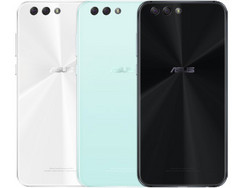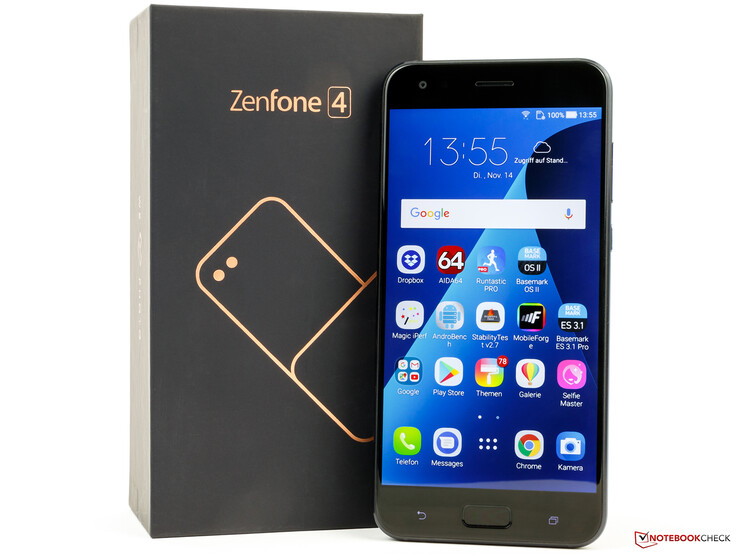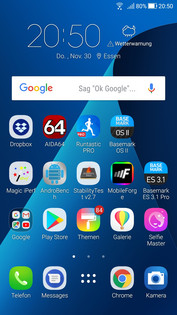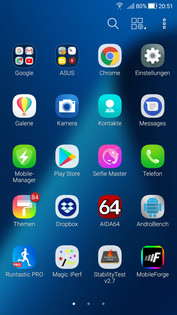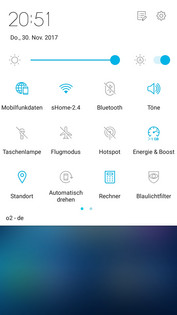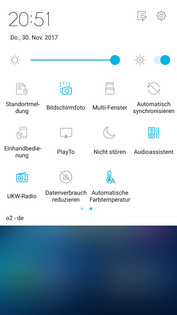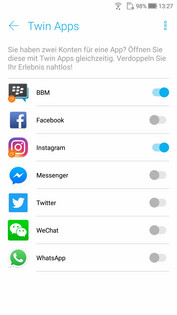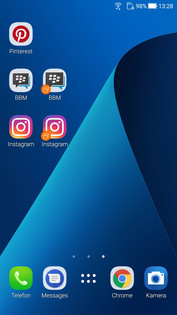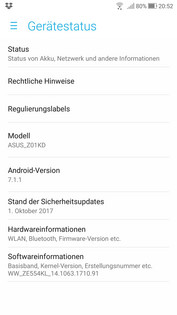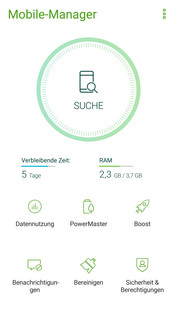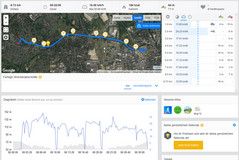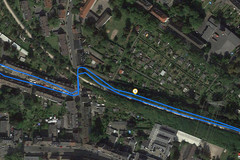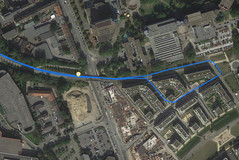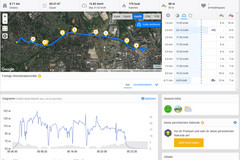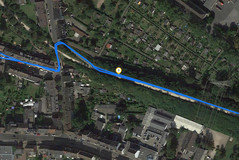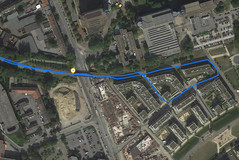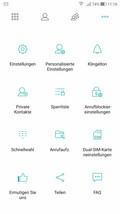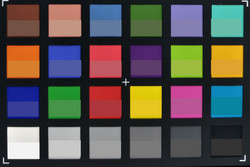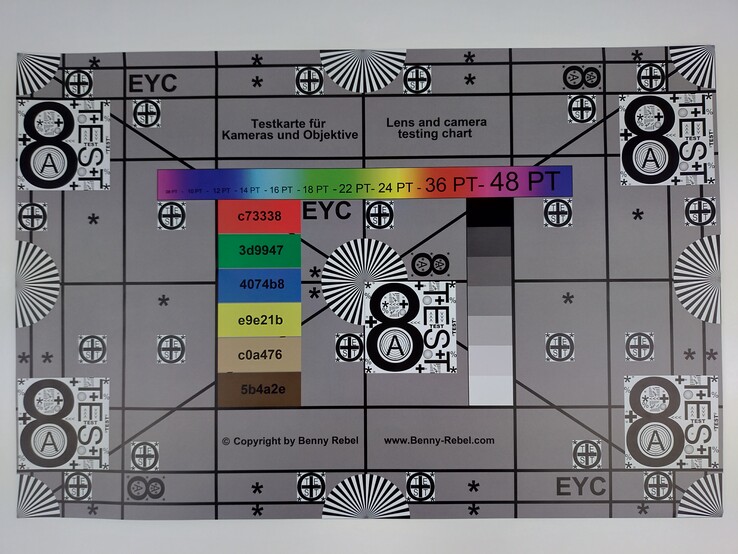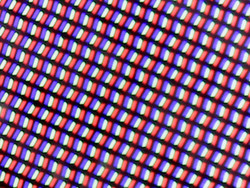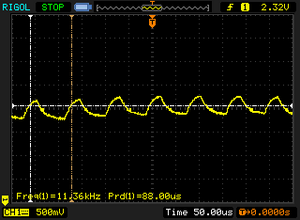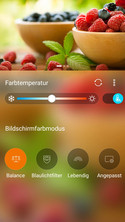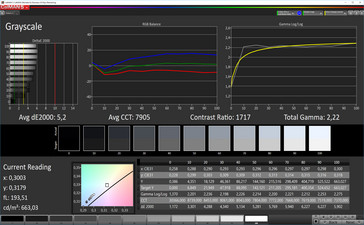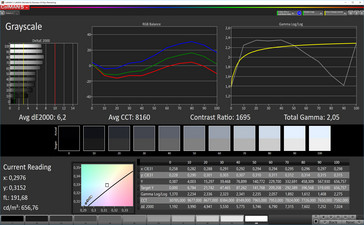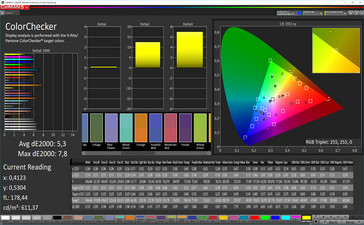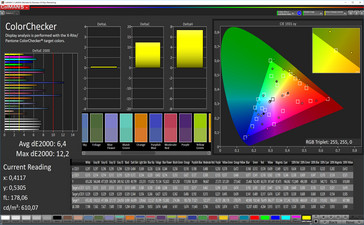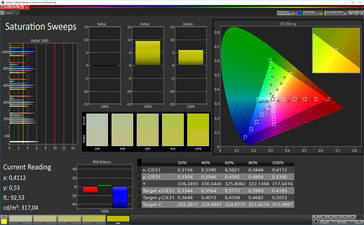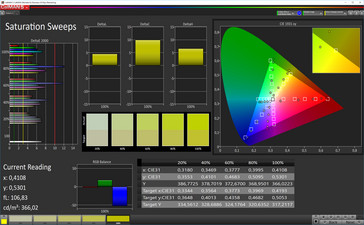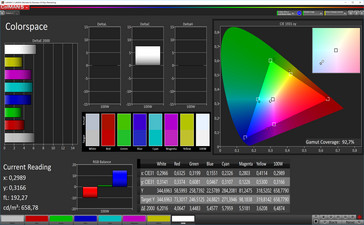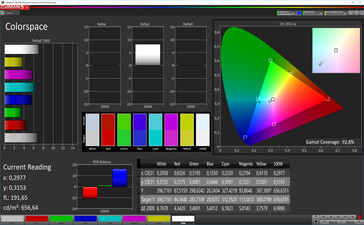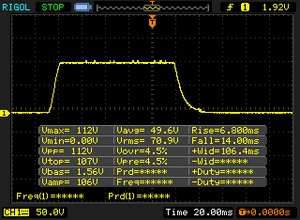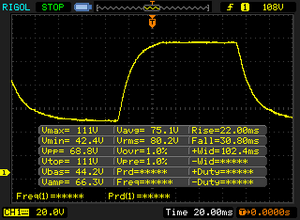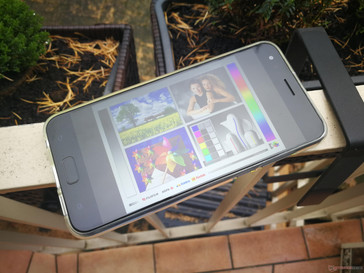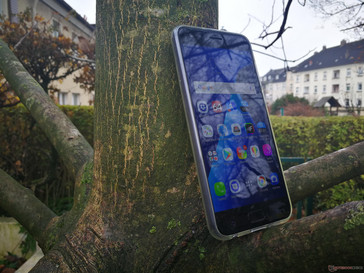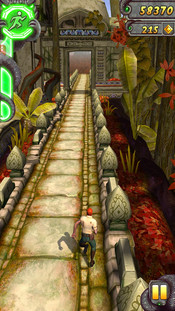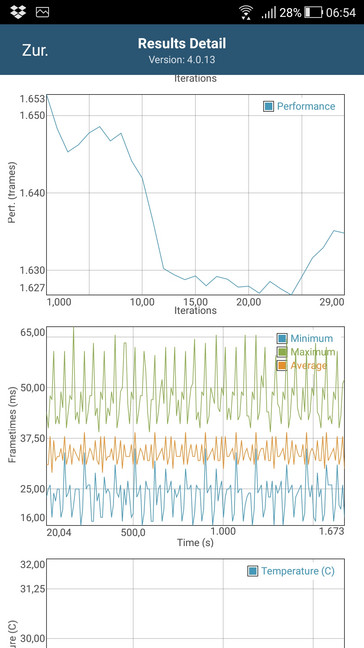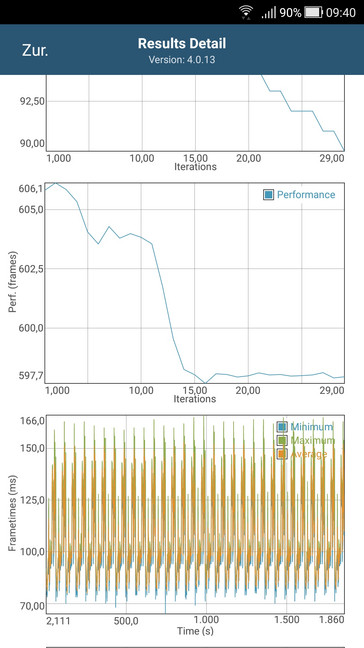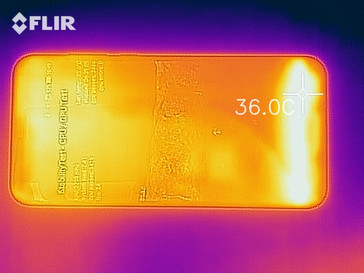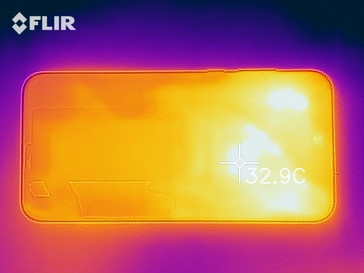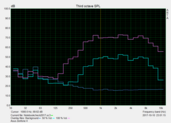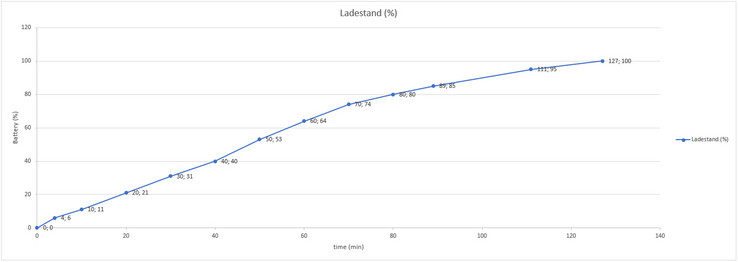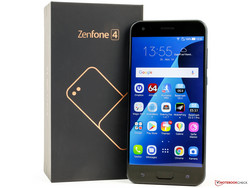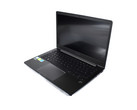Asus ZenFone 4 ZE554KL Smartphone Review
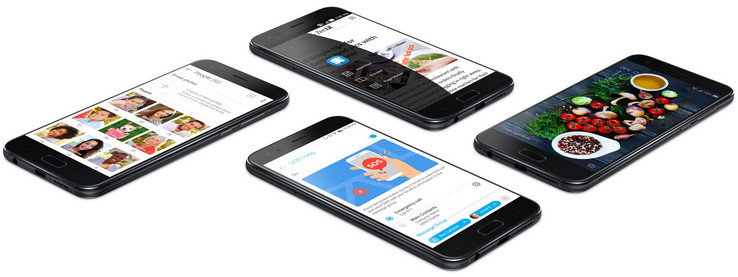
With the new ZenFone 4, Asus launches an upper-middle class smartphone with a 5.5-inch screen coming in the typical 16:9 screen ratio. At €499 (~$591), the ZenFone 4 comes with the Snapdragon 630, 4GB of RAM and 64GB of internal memory (Germany). A Pro version is due to come out by the end of the year. This Pro version will come with a Snapdragon 835 and will be the first ever smartphone to have ad-WLAN. ASUS’ new phone is all about its camera: its dual-lens camera uses Dual Pixel technology and is capable of wide-angle shots. This makes it a direct competitor of LG’s G6, which, at the time of this review, is even more affordable.
Although the price range of about €500 houses few competitors, flagship smartphones of the previous generations such as the Samsung Galaxy S7, the LG G6 and Huawei’s P10 can be found around there. The BQ Aquaris X Pro tries to fill the same niche, but its SRP is lower by around €100 (~$118). Other strong competitors are the smaller Honor 9, but other larger phones such as the OnePlus 5 and Nokia 8 also come at similar prices.
Case
In Germany, Asus offers the phone in black and white, with another mint-green variant being available internationally. The device’s design is appealingly sleek and simple, its camera is flush with the case, so that it can be put down flat on a table. Corning Gorilla Glass protects both front and back of the phone, making it prone to slide from surfaces that are not completely level. Although smudges and fingerprints appear visibly on the phone’s surface, they can be removed easily.
The ZenFone’s build quality is good and its frame makes it a robust device that is resistant to bending. The frame’s spacing is even and it fits to the phone's body snugly, just as we like it. The card slot cover is flush with the case and made from the same material, with the inner card slide being made from plastic. It either takes two Nano-SIM cards or one Nano-Sim card and a micro-SD card.
The phone’s battery is built in and its case is not IPA-certified.
Connectivity
The ZenFone’s USB C port actually houses a USB C 2.0 interface, which does not interconnect with display cables. It is, however, capable of OTG and can connect to external storage devices and peripherals.
The microSD slot takes cards up to a capacity or 2 TB, which is the maximum capacity denominated by the SDXC standard. At the time of this review the largest available microSD-cards store about 400GB. The ZenFone 4 cannot format microSDs for use as internal memory or transfer apps to them.
The device also supports wireless communications via VHF-band, Miracast Wi-Fi Direct, NFC and Bluetooth 5.0. Bluetooth 5.0 is utilized only after an update to Android 8.0 Oreo, with Bluetooth 4.2 being used otherwise.
Software
The ZenFone 4 comes with Android 7.1.1 Nougat and the new ZenUI 4.0 pre-installed. At the time of this review, the phone’s security standards were up to date, with the latest update having been delivered on October 1st 2017. During the time of this review, we noticed regular updates to this phone’s system. Its update to Android 8.0 Oreo is to be rolled out in 2018.
The new ZenUI 4.0 seems to be more cleaned up and less experimental than 3.0. Its user interface provides many features: the AI-supported gallery feature can automatically sort pictures by face recognition or group photos. The so-called Safeguard function can send the device’s location to a pre-defined contact in case of emergency so help can arrive more quickly. Furthermore, it is now possible to duplicate apps, so one can use multiple accounts comfortably. Altogether, ZenUI’s smooth experience and many useful features satisfied our expectations.
Communication and GPS
The Asus ZenFone 4 accesses the internet by LTE Cat 13 on the go, meaning that it is capable of 600 Mbit/s download and 150 Mbit/s upload maximum. The number of bands supported by the device is also very good. If 4G were unavailable at a time, it would still be able to connect to a wide variety of 3G-bands and Quad-Band-GSM. Connection quality was just fine and, altogether, above criticism.
The ZenFone 4 supports the IEEE-802.11-standards a, b, g, and ac and both 2.4 GHz and 5 GHz networks. In direct comparison to our reference router Linksys EA8500, the device did convince us and achieved consistently good results in sending and receiving data, which could only be improved with MIMO-antenna technology. Its reception range was decent too, with it being capable of streaming HD video content 12 meters (~39 ft) away from the router and separated by an exterior wall.
| Networking | |
| iperf3 transmit AX12 | |
| OnePlus 5 | |
| Huawei P10 | |
| Asus ZenFone 4 ZE554KL | |
| Nokia 8 | |
| BQ Aquaris X Pro | |
| Honor 9 | |
| Lenovo Moto Z2 Play | |
| iperf3 receive AX12 | |
| OnePlus 5 | |
| Asus ZenFone 4 ZE554KL | |
| Huawei P10 | |
| Honor 9 | |
| BQ Aquaris X Pro | |
| Nokia 8 | |
| Lenovo Moto Z2 Play | |
The smartphone supports various satellite constellations: GPS, GLONASS, BeiDou and Galileo. In our review, the ZenFone 4 also received position data from the Japanese network QZSS. Satellite fix was achieved within two seconds and was accurate within three meters (~10 ft). A relatively accurate fix was possible, even within buildings.
We put the ZenFone 4 through its paces alongside the Garmin Edge 500 with the mandatory bike ride. The recorded route is comparatively accurate, with the only noticeable divergence happening at the ascent to the embankment. The measured total distance also deviates only slightly from our cycling computer’s recording.
Telephone and Call Quality
The call app has been refined by ASUS and using it will not be a challenge to anyone. The contacts tab is now accompanied by a tab for groups and the related menu provides fast access to numerous useful features.
The Asus ZenFone 4’s call quality is good overall. Held close to the ear, both conversational partners are transmitted clearly. The phone's speaker is decent as well, although it sounds a bit tinny. Asus’ own Noise Reduction technology performs quite well. Unfortunately, the phone does not support VoLTE and VOWi-Fi in Germany.
Cameras
The ZenFone 4’s front camera features a sensitive 8 MP sensor with an aperture of f/2.0. It performs adequately in everyday use. Daylight shots turn out well and there is even the option of using a versatile beauty filter or a portrait mode. This portrait mode is supposed to simulate better depth perception, but does not quite achieve it. In adverse lighting conditions, picture quality deteriorated slightly, although the resultant pictures were still decent enough to use for social media.
The rear-facing dual camera features one 12 MP sensor and one 8 MP sensor. The main lenses’ focal length is 25 mm (83° wide-angle). Its sensor is the Sony IMX362, which is also utilized by the Moto Z2 Play and the HTC U11. Pictures in daylight come out notably well with this light-sensitive camera, even better than with the OnePlus 5, which has overexposure problems with depicting larger, bright surfaces. Finer details especially seem to come out better with the ZenFone 4’s camera. In bad lightning conditions, the large, light-sensitive pixels of the phone’s sensor and its optical and digital image stabilization perform well, as we could ascertain on our test device. At maximum zoom, image noise levels are higher than with the Note 8, but lettering is depicted more cleanly and with less pixelation. The second camera lens has a wider focal length at 12 mm (120°) and is less light-sensitive. The differences between these two lenses are like night and day, however, so we do not recommend using it for anything other than landscapes or architecture and panorama shots. The dual-camera’s shutter delay is small enough that it is suitable for point-and-shoot-use. Super Resolution Mode takes pictures with up to 49 MP. The camera’s pro mode offers a multitude of options for manual adjustment.
Videos are recorded in ultra HD at best (30 FPS, EIS), although unfortunately, the second lens cannot be used for this purpose. This does not impact the video-recording experience in low-light conditions however, since the light-sensitive lens by itself produces visible image noise and the autofocus behaves erratically already. Nevertheless, in daylight conditions and only slightly dark scenes, the camera performs well. Moreover, there are time lapse mode (max. 4k) and slow-motion mode (1080p @ 120 FPS or 720p @240 FPS).
We checked the ZenFone 4’s color accuracy under normalized and controlled conditions with our ColorChecker Passport. The images were processed without further editing. We found that whites were slightly warmer and grays brighter than in the original. Colors were slightly oversaturated and browns had a slight red hue.
Our test chart photo shows great quality in the image center, with high levels of detail discernible. The depiction of lettering on darker surfaces or color gradients turned out particularly well, with hardly any pixelation. On the other hand, sharpness drops considerably on the left side of the picture.
Accessories and Warranty
The package includes a modular charger (5V, 2A), a USB cable, and a tool for the SIM-card, a headset, a silicon bumper and a short user manual.
In Germany, Asus offers a 24-month warranty for the ZenFone 4. Please see our Guarantees, Return Policies and Warranties FAQ for country-specific information.
Input Devices and Handling
The capacitive touchscreen of the ZenFone 4 can recognize ten simultaneous activations and has an agreeably smooth surface that makes sliding across it easy. Additionally, the touchscreen’s precision is high, with even light touches being recognized. An optional glove mode can be activated through the device’s settings.
The phone utilizes Asus’ own ZenUI-keyboard, which is replete with features, but takes a lot of space on the screen. Especially in landscape mode nothing of the input text remains visible. Those who prefer other keyboard layouts can always install different ones from the Google Play Store.
The device’s fingerprint sensor is integrated into the frontal home button and unlocks it reliably and fast. Unlocking it this way in standby mode directly opens the home screen.
Display
The Asus ZenFone 4’s 5.5-inch IPS display’s resolution is 1920x1080 (16:9). The panel’s image is crisp and its vivid colors and contrast levels are convincingly good. This impression was verified by our test results. The average brightness is at a very high 634 cd/m² and is consistently distributed. The results remain constant even with the device’s ambient light sensor activated or in the APL 50 test. The screen’s good black level (0.4 cd/m²) provides for a very good contrast ratio.
No halation was detected. One shortcoming of the screen is the use of Pulse Width Modulation for brightness regulation.
The frequency is so high; however, that hardly anyone should be troubled by it.
| |||||||||||||||||||||||||
Brightness Distribution: 93 %
Center on Battery: 656 cd/m²
Contrast: 1640:1 (Black: 0.4 cd/m²)
ΔE ColorChecker Calman: 5.3 | ∀{0.5-29.43 Ø4.78}
ΔE Greyscale Calman: 5.2 | ∀{0.09-98 Ø5}
Gamma: 2.22
CCT: 7905 K
| Asus ZenFone 4 ZE554KL IPS, 1920x1080, 5.5" | BQ Aquaris X Pro IPS, 1920x1080, 5.2" | Lenovo Moto Z2 Play AMOLED, 1920x1080, 5.5" | Honor 9 IPS/LTPS, 1920x1080, 5.2" | OnePlus 5 AMOLED, 1920x1080, 5.5" | Huawei P10 LTPS, 1920x1080, 5.1" | Nokia 8 IPS, 2560x1440, 5.3" | |
|---|---|---|---|---|---|---|---|
| Screen | -44% | -10% | 7% | 20% | -7% | -34% | |
| Brightness middle (cd/m²) | 656 | 458 -30% | 434 -34% | 550 -16% | 426 -35% | 547 -17% | 735 12% |
| Brightness (cd/m²) | 634 | 473 -25% | 404 -36% | 535 -16% | 431 -32% | 556 -12% | 707 12% |
| Brightness Distribution (%) | 93 | 88 -5% | 81 -13% | 92 -1% | 93 0% | 86 -8% | 92 -1% |
| Black Level * (cd/m²) | 0.4 | 0.51 -28% | 0.42 -5% | 0.43 -8% | 0.79 -98% | ||
| Contrast (:1) | 1640 | 898 -45% | 1310 -20% | 1272 -22% | 930 -43% | ||
| Colorchecker dE 2000 * | 5.3 | 7.1 -34% | 4.4 17% | 3.3 38% | 1.6 70% | 4.8 9% | 6.7 -26% |
| Colorchecker dE 2000 max. * | 7.8 | 14.5 -86% | 8.6 -10% | 4.5 42% | 4.1 47% | 8.8 -13% | 12.9 -65% |
| Greyscale dE 2000 * | 5.2 | 10.5 -102% | 4.2 19% | 3.6 31% | 1.7 67% | 4.5 13% | 8.3 -60% |
| Gamma | 2.22 99% | 2.28 96% | 2.24 98% | 2.38 92% | 2.25 98% | 2.39 92% | 2.24 98% |
| CCT | 7905 82% | 8951 73% | 7343 89% | 7226 90% | 6329 103% | 7194 90% | 8906 73% |
* ... smaller is better
Screen Flickering / PWM (Pulse-Width Modulation)
| Screen flickering / PWM detected | 11360 Hz | ≤ 35 % brightness setting | |
The display backlight flickers at 11360 Hz (worst case, e.g., utilizing PWM) Flickering detected at a brightness setting of 35 % and below. There should be no flickering or PWM above this brightness setting. The frequency of 11360 Hz is quite high, so most users sensitive to PWM should not notice any flickering. In comparison: 53 % of all tested devices do not use PWM to dim the display. If PWM was detected, an average of 8108 (minimum: 5 - maximum: 343500) Hz was measured. | |||
We measured the display with the CalMAN software and a spectrophotometer. The ZenFone 4 has various color settings, with a blue light filter and modes such as ‘balanced’, ‘vivid’ and even one that enables the user to manually set color hue and saturation available. We tested the modes ‘balanced’ and ‘vivid’. The panel aligns itself with the sRGB spectrum in all modes. Both tested modes displayed colors with a slight shift to cooler shades, which should be possible to correct with color temperature adjustment. Blues in particular are displayed too vividly, causing higher deviations with shades of blue, while reds are somewhat undersaturated in ‘balanced’ mode. ‘Vivid’ mode produces vivid colors, particularly when displaying photos. At no time the color deviations were found to be disturbing.
The display’s feature to automatically adjust its color temperature to ambient light was particularly useful in everyday use.
Display Response Times
| ↔ Response Time Black to White | ||
|---|---|---|
| 20.8 ms ... rise ↗ and fall ↘ combined | ↗ 6.8 ms rise | |
| ↘ 14 ms fall | ||
| The screen shows good response rates in our tests, but may be too slow for competitive gamers. In comparison, all tested devices range from 0.1 (minimum) to 240 (maximum) ms. » 45 % of all devices are better. This means that the measured response time is similar to the average of all tested devices (20.2 ms). | ||
| ↔ Response Time 50% Grey to 80% Grey | ||
| 52.8 ms ... rise ↗ and fall ↘ combined | ↗ 22 ms rise | |
| ↘ 30.8 ms fall | ||
| The screen shows slow response rates in our tests and will be unsatisfactory for gamers. In comparison, all tested devices range from 0.165 (minimum) to 636 (maximum) ms. » 89 % of all devices are better. This means that the measured response time is worse than the average of all tested devices (31.6 ms). | ||
Outdoors, the Asus ZenFone 4's screen performs very well, probably due to its high brightness. Its surface is slightly reflective, but we are used to worse and with a direct viewing angle, the display quality should not be impacted negatively, at least as long as it is not exposed to direct sunshine.
Performance
The Asus ZenFone 4 is the very first smartphone equipped with the Qualcomm Snapdragon 630 (14 nm process) that we have examined. The octa-core CPU has not changed noticeably and consists of Cortex-53 cores, which are clocked at up to 2.2 GHz. The integrated graphics unit Adreno 508 is a new addition, however, and is marketed to perform up to 30% better compared to its predecessor, even with identical clock rates. The ZenFone 4 now supports and carries 4GB of LPDDR4 RAM.
In Geekbench, the ZenFone4 is slightly outperformed by the Snapdragon 626 on both the Moto Z2 Play and the Aquaris X Pro, which might be due to the different versions of Geekbench used, considering that both CPUs have nominally identical architecture and performance. The Snapdragon 630 also performs slightly worse in the Physics benchmark of 3DMark. None of these three can compete with the performance of high-end smartphones.
The higher performance of the GPU is immediately noticeable. In GFXBench, the Adreno 508 was between 30 and 51% faster than its predecessor, and even between 37 and 92% in 3DMark. Thus, the GPU is positioned evenly with the Adreno 510 or the ARM Mali-T880 MP4.
The ZenFone 4’s system performance is no match for high-end smartphones, but it stands up well to its direct competition and our test results confirm our good impression of the device’s smooth UI. Despite the elaborate ZenUI, the smartphone performs faster than the Z2 Play or X Pro, which rely on android’s stock UI.
| AnTuTu v6 - Total Score (sort by value) | |
| Asus ZenFone 4 ZE554KL | |
| BQ Aquaris X Pro | |
| Lenovo Moto Z2 Play | |
| Honor 9 | |
| OnePlus 5 | |
| Huawei P10 | |
| Nokia 8 | |
| PCMark for Android | |
| Work performance score (sort by value) | |
| Asus ZenFone 4 ZE554KL | |
| BQ Aquaris X Pro | |
| Lenovo Moto Z2 Play | |
| Honor 9 | |
| OnePlus 5 | |
| Huawei P10 | |
| Nokia 8 | |
| Work 2.0 performance score (sort by value) | |
| Asus ZenFone 4 ZE554KL | |
| BQ Aquaris X Pro | |
| Lenovo Moto Z2 Play | |
| Honor 9 | |
| OnePlus 5 | |
| Huawei P10 | |
| Nokia 8 | |
| Geekbench 4.4 | |
| 64 Bit Single-Core Score (sort by value) | |
| Asus ZenFone 4 ZE554KL | |
| BQ Aquaris X Pro | |
| Lenovo Moto Z2 Play | |
| Honor 9 | |
| OnePlus 5 | |
| Huawei P10 | |
| Nokia 8 | |
| 64 Bit Multi-Core Score (sort by value) | |
| Asus ZenFone 4 ZE554KL | |
| BQ Aquaris X Pro | |
| Lenovo Moto Z2 Play | |
| Honor 9 | |
| OnePlus 5 | |
| Huawei P10 | |
| Nokia 8 | |
| Compute RenderScript Score (sort by value) | |
| Asus ZenFone 4 ZE554KL | |
| Lenovo Moto Z2 Play | |
| Honor 9 | |
| OnePlus 5 | |
| Huawei P10 | |
| GFXBench (DX / GLBenchmark) 2.7 | |
| T-Rex Onscreen (sort by value) | |
| Asus ZenFone 4 ZE554KL | |
| BQ Aquaris X Pro | |
| Lenovo Moto Z2 Play | |
| Honor 9 | |
| OnePlus 5 | |
| Huawei P10 | |
| Nokia 8 | |
| 1920x1080 T-Rex Offscreen (sort by value) | |
| Asus ZenFone 4 ZE554KL | |
| BQ Aquaris X Pro | |
| Lenovo Moto Z2 Play | |
| Honor 9 | |
| OnePlus 5 | |
| Huawei P10 | |
| Nokia 8 | |
| GFXBench 3.0 | |
| on screen Manhattan Onscreen OGL (sort by value) | |
| Asus ZenFone 4 ZE554KL | |
| BQ Aquaris X Pro | |
| Lenovo Moto Z2 Play | |
| Honor 9 | |
| OnePlus 5 | |
| Huawei P10 | |
| Nokia 8 | |
| 1920x1080 1080p Manhattan Offscreen (sort by value) | |
| Asus ZenFone 4 ZE554KL | |
| BQ Aquaris X Pro | |
| Lenovo Moto Z2 Play | |
| Honor 9 | |
| OnePlus 5 | |
| Huawei P10 | |
| Nokia 8 | |
| GFXBench 3.1 | |
| on screen Manhattan ES 3.1 Onscreen (sort by value) | |
| Asus ZenFone 4 ZE554KL | |
| BQ Aquaris X Pro | |
| Lenovo Moto Z2 Play | |
| Honor 9 | |
| OnePlus 5 | |
| Huawei P10 | |
| Nokia 8 | |
| 1920x1080 Manhattan ES 3.1 Offscreen (sort by value) | |
| Asus ZenFone 4 ZE554KL | |
| BQ Aquaris X Pro | |
| Lenovo Moto Z2 Play | |
| Honor 9 | |
| OnePlus 5 | |
| Huawei P10 | |
| Nokia 8 | |
| GFXBench | |
| on screen Car Chase Onscreen (sort by value) | |
| Asus ZenFone 4 ZE554KL | |
| BQ Aquaris X Pro | |
| Lenovo Moto Z2 Play | |
| Honor 9 | |
| OnePlus 5 | |
| Huawei P10 | |
| Nokia 8 | |
| 1920x1080 Car Chase Offscreen (sort by value) | |
| Asus ZenFone 4 ZE554KL | |
| BQ Aquaris X Pro | |
| Lenovo Moto Z2 Play | |
| Honor 9 | |
| OnePlus 5 | |
| Huawei P10 | |
| Nokia 8 | |
| Lightmark - 1920x1080 1080p (sort by value) | |
| Asus ZenFone 4 ZE554KL | |
| Huawei P10 | |
| Basemark X 1.1 | |
| Medium Quality (sort by value) | |
| Huawei P10 | |
| High Quality (sort by value) | |
| Huawei P10 | |
| Basemark ES 3.1 / Metal - offscreen Overall Score (sort by value) | |
| Asus ZenFone 4 ZE554KL | |
| Huawei P10 | |
| Epic Citadel - Ultra High Quality (sort by value) | |
| Huawei P10 | |
We tested browser performance on the preinstalled Chrome version 62. Web pages were loaded swiftly and displayed without issue. The benchmarks put the ZenFone 4 alongside its opponents equipped with Snapdragon 600 CPUs and show that it cannot compete with faster devices.
| JetStream 1.1 - Total Score | |
| OnePlus 5 (Chrome 59) | |
| Nokia 8 (Chrome 61.0.3163.98) | |
| Honor 9 (Chrome 59) | |
| Huawei P10 (Chrome 56) | |
| Lenovo Moto Z2 Play (Chrome 59) | |
| Asus ZenFone 4 ZE554KL (Chrome 62) | |
| BQ Aquaris X Pro (Chrome 59.0.3071.125) | |
| Octane V2 - Total Score | |
| OnePlus 5 (Chrome 59) | |
| Nokia 8 (Chrome 61.0.3163.98) | |
| Huawei P10 (Chrome 56) | |
| Honor 9 (Chrome 59) | |
| Lenovo Moto Z2 Play (Chrome 59) | |
| BQ Aquaris X Pro (Chrome 59.0.3071.125) | |
| Asus ZenFone 4 ZE554KL (Chrome 62) | |
| Mozilla Kraken 1.1 - Total | |
| Asus ZenFone 4 ZE554KL (Chrome 62) | |
| BQ Aquaris X Pro (Chrome 59.0.3071.125) | |
| Lenovo Moto Z2 Play (Chrome 59) | |
| Nokia 8 (Chrome 61.0.3163.98) | |
| Honor 9 (Chrome 59) | |
| Huawei P10 (Chrome 56) | |
| OnePlus 5 (Chrome 59) | |
| WebXPRT 2015 - Overall | |
| Nokia 8 (Chrome 61.0.3163.98) | |
| OnePlus 5 (Chrome 59) | |
| Huawei P10 (Chrome 56) | |
| Honor 9 (Chrome 59) | |
| Asus ZenFone 4 ZE554KL (Chrome 62) | |
| BQ Aquaris X Pro (Chrome 59.0.3071.125) | |
| Lenovo Moto Z2 Play (Chrome 59) | |
* ... smaller is better
The Asus ZenFone 4’s eMMC memory is not among the fastest options. It performed averagely in most tests, but was exceedingly bad at writing small data blocks, which impacts the overall test result negatively. This also results in noticeable slowdown when installing apps and updates. The device’s 64 GB of memory is reduced to 54 GB of usable memory after the initial startup. Media and photos can be stored on the optional microSD card.
We tested the microSD slot’s speed with our Toshiba Exceria Pro M501 reference card (max. read: 270 MB/s, max. write: 150 MB/s). The card remains underutilized, but the smartphone’s microSD slot still is fast in comparison to some competing devices.
| Asus ZenFone 4 ZE554KL | BQ Aquaris X Pro | Honor 9 | OnePlus 5 | Huawei P10 | Nokia 8 | Lenovo Moto Z2 Play | |
|---|---|---|---|---|---|---|---|
| AndroBench 3-5 | -10% | 41% | 105% | 352% | 51% | 70% | |
| Sequential Read 256KB (MB/s) | 287.4 | 270.5 -6% | 293 2% | 748 160% | 738 157% | 680 137% | 245.6 -15% |
| Sequential Write 256KB (MB/s) | 205.3 | 139.6 -32% | 204 -1% | 201.5 -2% | 189.8 -8% | 199.1 -3% | 137.5 -33% |
| Random Read 4KB (MB/s) | 68.6 | 37.97 -45% | 55.7 -19% | 141 106% | 168.4 145% | 145.7 112% | 38.2 -44% |
| Random Write 4KB (MB/s) | 7.59 | 12.07 59% | 32.7 331% | 19.3 154% | 152.3 1907% | 14.57 92% | 47.9 531% |
| Sequential Read 256KB SDCard (MB/s) | 86.9 ? | 78.7 ? -9% | 68 ? -22% | 54.2 ? -38% | 76.8 ? -12% | 79.7 ? -8% | |
| Sequential Write 256KB SDCard (MB/s) | 66.5 ? | 49.77 ? -25% | 34.64 ? -48% | 32.19 ? -52% | 51.7 ? -22% | 58.7 ? -12% |
Games
The Asus ZenFone 4 performs at a decent level, with all current APIs being supported. At present, no game from Play Store is expected to force reduced video quality settings. The phone comes equipped with Asus’ Game Genie, which is supposed to enhance game performance and can record and stream game sessions. There is also a lock mode which prevents accidental screen switching and a macro key function that can automate in-game functions.
Generally, the ZenFone 4 can be said to be a good companion for gaming on the go. The player’s input is processed precisely and the additional frontal speakerphone compensates when the second one on the lower edge is covered.
| Asphalt 8: Airborne | |||
| Settings | Value | ||
| high | 30 fps | ||
| very low | 30 fps | ||
| Real Racing 3 | |||
| Settings | Value | ||
| high | 32 fps | ||
| Temple Run 2 | |||
| Settings | Value | ||
| default | 58 fps | ||
| Dead Trigger 2 | |||
| Settings | Value | ||
| high | 30 fps | ||
Emissions
Temperature
The Asus ZenFone 4’s surface temperature levels remain low at idle and at constant load, giving no cause for criticism.
We tested the SoCs’ performance under load with the GFXBench battery test. No throttling was detected with OpenGL ES 2.0 or 3.1.
(+) The maximum temperature on the upper side is 35.3 °C / 96 F, compared to the average of 35.2 °C / 95 F, ranging from 21.9 to 247 °C for the class Smartphone.
(+) The bottom heats up to a maximum of 31.7 °C / 89 F, compared to the average of 34 °C / 93 F
(+) In idle usage, the average temperature for the upper side is 29.6 °C / 85 F, compared to the device average of 32.9 °C / 91 F.
Speakers
The Asus ZenFone 4’s two speakers’ sound quality is very high. One is located at ear-level and the other one at the lower edge of the smartphone. The device can be quite loud with 82 dB(A). What is more important, however, is its sound, and especially with mids and highs, the speakers deliver. Only the somewhat lacking bass impacts the overall sound volume and its lows.
Alternatively, the sound can be output through the 3.5 mm headphone jack, which transmits a clear and smooth signal. With DTS Headphone:X and high-resolution audio output (192 kHz/24-Bit), the ZenFone 4 is a pleasure to listen to. The included headset does not impress, but delivers a surprisingly balanced sound pattern. Those who prefer wireless playback over Bluetooth will be pleased that the device supports aptX HD.
Asus ZenFone 4 ZE554KL audio analysis
(+) | speakers can play relatively loud (82.2 dB)
Bass 100 - 315 Hz
(-) | nearly no bass - on average 28.3% lower than median
(±) | linearity of bass is average (8.1% delta to prev. frequency)
Mids 400 - 2000 Hz
(+) | balanced mids - only 3.7% away from median
(+) | mids are linear (6.5% delta to prev. frequency)
Highs 2 - 16 kHz
(+) | balanced highs - only 3.9% away from median
(+) | highs are linear (5.4% delta to prev. frequency)
Overall 100 - 16.000 Hz
(±) | linearity of overall sound is average (21.7% difference to median)
Compared to same class
» 43% of all tested devices in this class were better, 8% similar, 49% worse
» The best had a delta of 11%, average was 35%, worst was 134%
Compared to all devices tested
» 61% of all tested devices were better, 7% similar, 32% worse
» The best had a delta of 4%, average was 24%, worst was 134%
Lenovo Moto Z2 Play audio analysis
(+) | speakers can play relatively loud (86.8 dB)
Bass 100 - 315 Hz
(-) | nearly no bass - on average 30.9% lower than median
(±) | linearity of bass is average (9.6% delta to prev. frequency)
Mids 400 - 2000 Hz
(+) | balanced mids - only 4.9% away from median
(+) | mids are linear (5.3% delta to prev. frequency)
Highs 2 - 16 kHz
(+) | balanced highs - only 1.9% away from median
(+) | highs are linear (3.6% delta to prev. frequency)
Overall 100 - 16.000 Hz
(±) | linearity of overall sound is average (19.3% difference to median)
Compared to same class
» 26% of all tested devices in this class were better, 9% similar, 65% worse
» The best had a delta of 11%, average was 35%, worst was 134%
Compared to all devices tested
» 46% of all tested devices were better, 8% similar, 47% worse
» The best had a delta of 4%, average was 24%, worst was 134%
BQ Aquaris X Pro audio analysis
(+) | speakers can play relatively loud (86.1 dB)
Bass 100 - 315 Hz
(-) | nearly no bass - on average 26.4% lower than median
(±) | linearity of bass is average (10% delta to prev. frequency)
Mids 400 - 2000 Hz
(+) | balanced mids - only 4.5% away from median
(+) | mids are linear (5.9% delta to prev. frequency)
Highs 2 - 16 kHz
(±) | higher highs - on average 11.1% higher than median
(+) | highs are linear (6.7% delta to prev. frequency)
Overall 100 - 16.000 Hz
(±) | linearity of overall sound is average (26% difference to median)
Compared to same class
» 65% of all tested devices in this class were better, 6% similar, 28% worse
» The best had a delta of 11%, average was 35%, worst was 134%
Compared to all devices tested
» 79% of all tested devices were better, 4% similar, 16% worse
» The best had a delta of 4%, average was 24%, worst was 134%
Frequency comparison (Checkboxes selectable!)
Battery Life
Power Consumption
The Asus ZenFone 4’s power consumption is on a fairly high level, with the bright display drawing quite a bit of power, making the BQ Aquaris X Pro and Moto Z2 Play outlast it.
Our test device does not support wireless charging, but has QuickCharge 3.0 in return – so the specification sheet says. With the meager 10 watts of the included charger, a complete charge of the 3300 mAh takes more than 2 hours. A more powerful charger should cut down the measured time for a full charge.
| Off / Standby | |
| Idle | |
| Load |
|
Key:
min: | |
| Asus ZenFone 4 ZE554KL 3300 mAh | BQ Aquaris X Pro 3100 mAh | Honor 9 3200 mAh | OnePlus 5 3300 mAh | Huawei P10 3200 mAh | Nokia 8 3090 mAh | Lenovo Moto Z2 Play 3000 mAh | |
|---|---|---|---|---|---|---|---|
| Power Consumption | 16% | -12% | 2% | -14% | -8% | 56% | |
| Idle Minimum * (Watt) | 0.84 | 0.67 20% | 1.13 -35% | 0.73 13% | 0.83 1% | 0.86 -2% | 0.45 46% |
| Idle Average * (Watt) | 2.31 | 1.7 26% | 2.25 3% | 1.44 38% | 2.1 9% | 2.13 8% | 0.78 66% |
| Idle Maximum * (Watt) | 2.33 | 1.78 24% | 2.3 1% | 1.5 36% | 2.18 6% | 2.16 7% | 0.84 64% |
| Load Average * (Watt) | 4.76 | 4.42 7% | 4.89 -3% | 6.91 -45% | 6.57 -38% | 4.65 2% | 1.69 64% |
| Load Maximum * (Watt) | 6.39 | 6.3 1% | 7.99 -25% | 8.51 -33% | 9.32 -46% | 9.99 -56% | 3.79 41% |
* ... smaller is better
Battery Life
The Asus ZenFone 4’s battery life is impressive among the competition and is outbid only by the Motorola Moto Z2 Play.
The results were most easily compared at an adjusted screen brightness of 150 cd/m². At this level, the ZenFone 4 performed merely averagely, its comparatively large battery notwithstanding. In our WLAN test it made fifth place and in video playback it made third.
On that account, the test device offers an encompassing battery saving mode, which can be individually adjusted to the user’s needs. During our tests we also noted that the smartphone uses very little power in standby mode and only marginally discharges across the day.
| Asus ZenFone 4 ZE554KL 3300 mAh | BQ Aquaris X Pro 3100 mAh | Honor 9 3200 mAh | OnePlus 5 3300 mAh | Huawei P10 3200 mAh | Nokia 8 3090 mAh | Lenovo Moto Z2 Play 3000 mAh | |
|---|---|---|---|---|---|---|---|
| Battery runtime | 5% | -12% | -11% | 2% | -2% | 33% | |
| Reader / Idle (h) | 27.8 | 30.7 10% | 23.3 -16% | 25.6 -8% | 25.7 -8% | 25.1 -10% | 26.5 -5% |
| H.264 (h) | 11.6 | 10.7 -8% | 9.4 -19% | 10.4 -10% | 9.7 -16% | 12.2 5% | 15.8 36% |
| WiFi v1.3 (h) | 9.4 | 12.2 30% | 8.6 -9% | 8.6 -9% | 16.1 71% | 10.8 15% | 12.5 33% |
| Load (h) | 4.8 | 4.2 -12% | 4.6 -4% | 4.1 -15% | 2.9 -40% | 4 -17% | 8 67% |
Pros
Cons
Verdict
Asus manages to offer an attractive continuation of its ZenFone series with the ZenFone 4. Its design is elegant, yet simple and its system performance convinced us. Its networking speeds are impressive, with LTE Cat 13 and good WLAN performance. Along with the new Snapdragon CPU, Bluetooth has been updated to its latest iteration and geolocation works very well. The updated GPU catapults the ZenFone 4 forward within its class and its display is well suited to outdoor use. Regrettably, it utilizes PWM.
With the ZenFone 4, Asus offers a competitively equipped smartphone that revealed almost no flaws in our test findings.
Generally, the ZenFone 4 leaves little room for valid criticism. Unfortunately, its USB port conforms to USB 2.0 standard and the included charger’s power is too low to utilize the fast charging technology marketed for the smartphone. Our impression of the dual-lens camera was ambivalent: While the main camera is excellent, the secondary lens cannot compare and is reminiscent of the LG G5’s flaws. The camera can produce excellent photos without doubt, but its second lens might remain unused.
The ZenFone 4 also caters to music aficionados with features like high-resolution audio, DTS and aptX HD, not to mention the integrated headphone jack. At €500 (~$593), its pricing seems a bit steep but we strongly recommend the ZenFone 4 nevertheless.
Asus ZenFone 4 ZE554KL
- 12/01/2017 v6 (old)
Daniel Schmidt




